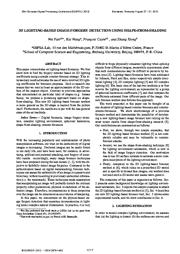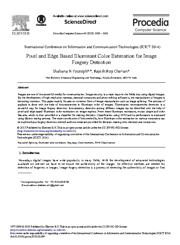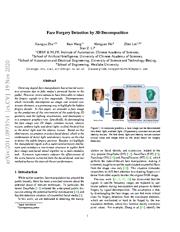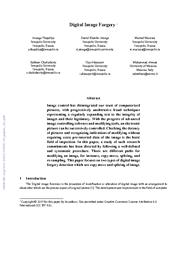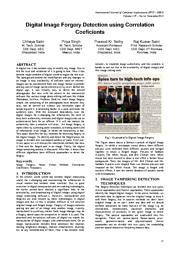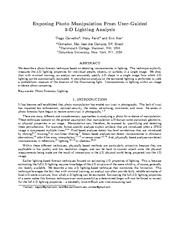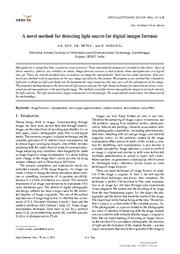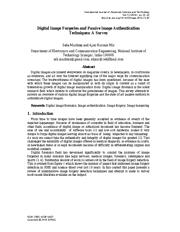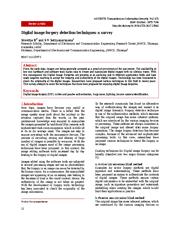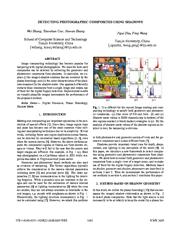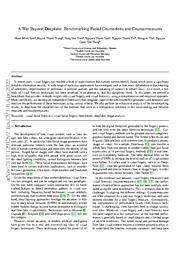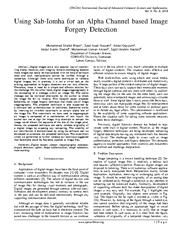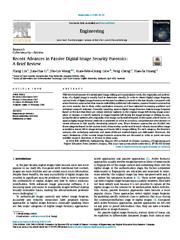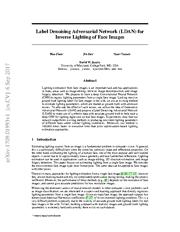A copy of this work was available on the public web and has been preserved in the Wayback Machine. The capture dates from 2020; you can also visit the original URL.
The file type is application/pdf.
Filters
3D Lighting-Based Image Forgery Detection Using Shape-From-Shading
2012
Zenodo
attacks. • Second, we use the shape-from-shading technique [8] for lighting environment estimation, which is new in the field of image forgery detection. ...
Therefore, we propose to use shape-from-shading to estimate 3D lighting coefficients in order to enhance the capabilities of the forgery detector. ...
doi:10.5281/zenodo.52254
fatcat:6tkxlsdtrvab7pbp7qp663dbke
Identifying Photo Forgery using Lighting Elements
2016
Indian Journal of Science and Technology
This paper focuses on detection of image forgery using lighting inconsistencies. The proposed technique measures the lighting properties from different objects or surfaces present in the image. ...
Method: By locating the direction of the light source, forgery in the images can be easily detected. Inconsistencies between different light sources in the image highlight image tampering. ...
The proposed approach generates the 3D shape which is further used to detect the 3D lighting in the image for various objects. ...
doi:10.17485/ijst/2016/v9i48/105748
fatcat:m3xeu4wfnjboba3ehxqoo3q56u
Pixel and Edge Based Illuminant Color Estimation for Image Forgery Detection
2015
Procedia Computer Science
Illumination inconsistencies detection is a powerful way for image forgery detection. ...
From these illuminant estimators, extract shape and color features, which is then provided to a classifier for making decision. ...
Proposing a different approach by using shape-from-shading (SFS) to estimate the 3D normal's of the underlying object. The main issue with this method is the estimation of the 3D shape of the object. ...
doi:10.1016/j.procs.2015.02.099
fatcat:smndts2jujabbhzu4osfmzdmfq
Face Forgery Detection by 3D Decomposition
[article]
2020
arXiv
pre-print
Specifically, by disentangling the face image into 3D shape, common texture, identity texture, ambient light, and direct light, we find the devil lies in the direct light and the identity texture. ...
Based on this observation, we propose to utilize facial detail, which is the combination of direct light and identity texture, as the clue to detect the subtle forgery patterns. ...
(a) Face Image, (b) Ambient Light + Common Texture + 3D Shape, (c) Identity Texture + Direct Light + 3D Shape, (d) Identity Texture + 3D Shape, (e) Face Image w/o Shape, (f) Ambient Light + Common Texture ...
arXiv:2011.09737v1
fatcat:fb7amik5nrgprkn75nuaiu5uua
Digital image forgery
2019
International Young Scientists Conference on Information Technologies, Telecommunications and Control Systems
This paper focuses on two types of digital image forgery detection which are copy move and splicing of image. ...
Image control has disintegrated our trust of computerized pictures, with progressively unobtrusive fraud techniques representing a regularly expanding test to the integrity of images and their legitimacy ...
The functioning of the algorithm is on the premise of distinction in the lighting condition. 2D light detection, 3D light detection and light environment are the three main categories for this method ...
dblp:conf/ittcs/AtongeTMCA19
fatcat:cidvvgo4dzeyjofdso65z3ulji
Digital Image Forgery Detection using Correlation Coeficients
2015
International Journal of Computer Applications
Images can be transformed from one image format to another and any part of image can be altered pixel by pixel. Before the digital age, it was literally easy to detect the altered photographs. ...
This paper identifies the key methods for detecting forgery in the digital images. To identify and detect the forged areas, the image is divided into overlapped patches of some fixed size. ...
The forgery detection approach using 3D lighting system is given by Fan et al. [4] , based on the shape by shading. ...
doi:10.5120/ijca2015907090
fatcat:d6ljysn3arfjddijs2wp5p6wly
Exposing photo manipulation from user-guided 3D lighting analysis
2015
Media Watermarking, Security, and Forensics 2015
We describe a photo forensic technique based on detecting inconsistencies in lighting. ...
We show that with minimal training, an analyst can accurately specify 3-D shape in a single image from which 3-D lighting can be automatically estimated. ...
Shown in Figure 6 is a forgery based on the image in Figure 1 . ...
doi:10.1117/12.2075544
dblp:conf/mediaforensics/CarvalhoFK15
fatcat:b43wowhuwfhuxfamwbiycrahtm
A novel method for detecting light source for digital images forensic
2011
Opto-Electronics Review
We propose a new method that is based on light and its shade as light and shade are the fundamental input resources that may carry all the information of the image. ...
The proposed method measures the direction of light source and uses the light based technique for identification of any intentional partial manipulation in the said digital image. ...
While deletion can be detected using segmentation based on intensity, copy and paste is detected by duplication based segmentation. Texture based segmen− tation is used for healing tool forgery. ...
doi:10.2478/s11772-011-0014-6
fatcat:lnkmjicjxrbvxd275nkdotkfqe
Digital Image Forgeries and Passive Image Authentication Techniques: A Survey
2014
International Journal of Advanced Science and Technology
This survey attempts to provide an overview of various digital image forgeries and the state of art passive methods to authenticate digital images. ...
Digital image forensics is the latest research field which intends to authorize the genuineness of images. ...
., [93] proposed a method that described that methods based on forgery detection using 2D lighting system can be fooled easily and gave a promising technique based on shape from shading. ...
doi:10.14257/ijast.2014.73.02
fatcat:r3nprjpe6je4pkc72pytsnndmy
Digital image forgery detection techniques: a survey
2016
ACCENTS Transactions on Information Security
., [31] proposed a technique which infers that methods based on forgery detection using 2D lighting system can be fooled easily and gave a promising technique based on shape from shading. ...
This approach is more general but the issue of estimation of 3D shapes of objects remains. ...
This paper is selected from proceedings of National Workshop on Cryptology-NWC 2016 organized at JNN College of Engineering Shimoga, Karnataka, India during 11-13, August 2016. ...
doi:10.19101/tis.2017.25003
fatcat:vyi63ahmrvfeljjpqqiooxy334
Detecting photographic composites using shadows
2009
2009 IEEE International Conference on Multimedia and Expo
Our approach efficiently extracts these constraints from a single image and makes use of them for the digital forgery detection. ...
We describe how such composites can be detected by enforcing the geometric and photometric constraints from shadows. ...
The latter approaches [7, 8] use inconsistencies in the lighting for detecting forgeries. ...
doi:10.1109/icme.2009.5202676
dblp:conf/icmcs/ZhangCZZW09
fatcat:zjczhisuzjcyldnjuxf2lb4ip4
A War Beyond Deepfake: Benchmarking Facial Counterfeits and Countermeasures
[article]
2022
arXiv
pre-print
In this paper, we present a benchmark that provides in-depth insights into visual forgery and visual forensics, using a comprehensive and empirical approach. ...
In recent years, visual forgery has reached a level of sophistication that humans cannot identify fraud, which poses a significant threat to information security. ...
This is a graphics-based technique that is also used to model a person's face in 3D with shapes and textures [24] . ...
arXiv:2111.12912v2
fatcat:mg5qfusog5a7hcyuwb6m6wsjle
Using Sab-Iomha for an Alpha Channel based Image Forgery Detection
2018
International Journal of Advanced Computer Science and Applications
Although there exist some techniques to validate digital images, but in practice, it is not a trivial task as the existing approaches to forgery detection are not very effective. ...
This research paper proposes Sabiomha, an image forgery technique that make use of image steganography. The proposed technique is also supported by a software tool to demonstrate its usefulness. ...
Lighting, inconsistent shading, and shadows have been used as a method for collecting evidence on image forgery [5] . ...
doi:10.14569/ijacsa.2018.090849
fatcat:mfzpfpvgffh2npayooraecuixa
Recent Advances in Passive Digital Image Security Forensics: A Brief Review
2018
Engineering
Generally speaking, passive digital image forensics detects image forgeries based on the fact that there are certain intrinsic patterns in the original image left during image acquisition or storage, or ...
In order to detect digital image forgeries, various kinds of digital image forensics techniques have been proposed in the last decade. ...
Image-tampering detection using a lighting pattern The lighting environment in the real world is complex. Light sources are three dimensional (3D), and sometimes there are multiple light sources. ...
doi:10.1016/j.eng.2018.02.008
fatcat:vckmpckspreobdhlg2of6p3xma
Label Denoising Adversarial Network (LDAN) for Inverse Lighting of Face Images
[article]
2017
arXiv
pre-print
Lighting estimation from face images is an important task and has applications in many areas such as image editing, intrinsic image decomposition, and image forgery detection. ...
We propose to train a deep Convolutional Neural Network (CNN) to regress lighting parameters from a single face image. ...
Lighting estimation can be used in applications such as image editing, 3D structure estimation, and image forgery detection. This paper focuses on estimating lighting from a single face image. ...
arXiv:1709.01993v1
fatcat:z3yxyqllfnf5nntthzrsiuzzgu
« Previous
Showing results 1 — 15 out of 217 results

